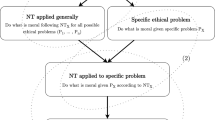Abstract
Human inference can be used to test the inference patterns a reliable nonmonotonic consequence should satisfy, because it appears to be nonmonotonic, it is adaptive and it generally achieves efficiency. In this study, an experiment is conducted to investigate whether human inference tends to be consistent with rationality postulates (System P plus Rational Monotony), especially when it no longer satisfies the Monotony property. The experimental protocol uses a possibilistic semantics for plausible rules. Our results appear to be consistent with all the studied properties. Exceptions are the Cut property (with one kind of content out of two) and Left Logical Equivalence which could not be tested. Moreover, when Monotony was not satisfied by participants' inferences, Cut, Cautious Monotony and And properties were corroborated (Rational Monotony was only plausibly supported and the other properties were not tested). Our results emphasize the psychological plausibility of rationality postulates and support the working hypothesis in Artificial Intelligence that System P plus Rational Monotony offer a plausible basic set of properties for nonmonotonic logics.
Similar content being viewed by others
References
S. Benferhat, D. Dubois and H. Prade, Representing default rules in possibilistic logic, in: Proc. of the 3rd Internat. Conf. on Principles of Knowledge Representation and Reasoning KR'92 (Cambridge, MA, 1995) pp. 673-684.
S. Benferhat, R. Da Silva Neves, D. Dubois, H. Prade and E. Raufaste, Qualitative approaches to reasoning under uncertainty: Formal developments and experimental validations, part 1: Possibility theory, Research Report LTC-CERPP-IRIT/00-17 R (2000).
J.F. Bonnefon and D.J. Hilton, The suppression of Modus Ponens as a case of pragmatic preconditional reasoning. To appear in Thinking and Reasoning.
R.M.J. Byrne, Suppressing valid inferences with conditionals, Cognition 31 (1989) 61-83.
D. Chan and F. Chua, Suppression of valid inferences: syntactic views, mental models, and relative salience, Cognition 53 (1994) 217-238.
D. Dubois and H. Prade, Conditional objects, possibility theory and default rules, in: Conditionals: From Philosophy to Computer Sciences, eds. G. Crocco, L. Fariñas del Cerro and A. Herzig (Oxford University Press, Oxford, 1995) pp. 301-336.
D. Dubois and H. Prade, Possibility theory: Qualitative and quantitative aspects, in: Quantified Representation of Uncertainty and Imprecision, Handbook of Defeasible Reasoning and Uncertainty Management, Vol. I (Kluwer, Dordrecht, 1998).
R. Elio and F.J. Pelletier, The effect of syntactic form on simple belief revisions and updates, in: Proceedings of the 16th Annual Conference of the Cognitive Science Society (Lawrence Erlbaum, Hillsdale, NJ, 1994) pp. 260-265.
J.St.B.T. Evans, S.E. Newstead and R.M.J. Byrne, Human Reasoning: The Psychology of Deduction (Lawrence Erlbaum, London, 1993).
D.M. Gabbay, Theoretical foundations for non-monotonic reasoning in expert systems, in: Logics and Models of Concurrent Systems, ed. K.R. Apt (Springer, 1985) pp. 439-457.
P. Gärdenfors and D. Makinson, Nonmonotonic inference based on expectations, Artif. Intell. 65 (1994) 197-245.
C. George, The endorsement of the premises: Assumption-based or belief-based reasoning, British J. Psychology 86 (1995) 93-111.
S. Kraus, D. Lehmann and M. Magidor, Nonmonotonic reasoning, preferential models and cumulative logics, Artif. Intell. 44 (1990) 167-207.
D. Lehmann and M. Magidor, What does a conditional knowledge base entail?, Artif. Intell. 55 (1992) 1-60.
D. Makinson, General theory of cumulative inference, in: Proceedings Second International Workshop on Non-Monotonic Reasoning, Lectures Notes in Computer Science, eds. M. Reinfrank and J. De Kleer (Springer, Berlin, 1989).
D. Makinson, General patterns in nonmonotonic reasoning, in: Nonmonotonic and Uncertainty Reasoning, Handbook of Logic in Artificial Intelligence and Logic Programming, Vol. 3, eds. D.M. Gabbay et al. (Oxford University Press, Oxford, 1994) pp. 35-110.
J.L. Pollock, Defeasible reasoning, Cognitive Sci. 11 (1987) 481-518.
E. Raufaste and R.M. Da Silva Neves, Empirical evaluation of possibility theory in human radiological diagnosis, in: Proceedings of the 13th Biennal Conference on Artificial Intelligence, ECAI'98, ed. H. Prade (Wiley, London, 1998) pp. 124-128.
S. Siegel and N.J Castellan, Jr., Nonparametric Statistics for the Behavioral Sciences (McGraw-Hill, New York, 1988).
Y. Shoham, A semantical approach to nonmonotonic logics, in: Proceedings Logics in Computer Science, Ithaca, NY (1987) 275-279.
R.M. Stevenson and D.E. Over, Deduction from uncertain premises, Quart. J. Experiment. Psychol. 48A (1985) 613-643.
Author information
Authors and Affiliations
Rights and permissions
About this article
Cite this article
Da Silva Neves, R., Bonnefon, JF. & Raufaste, E. An Empirical Test of Patterns for Nonmonotonic Inference. Annals of Mathematics and Artificial Intelligence 34, 107–130 (2002). https://doi.org/10.1023/A:1014473706150
Issue Date:
DOI: https://doi.org/10.1023/A:1014473706150




